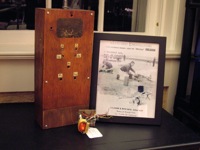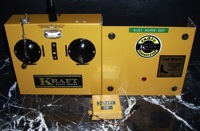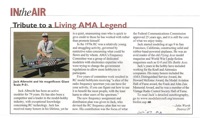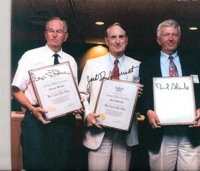Special Exhibit:
Jack Albrecht’s Schneider
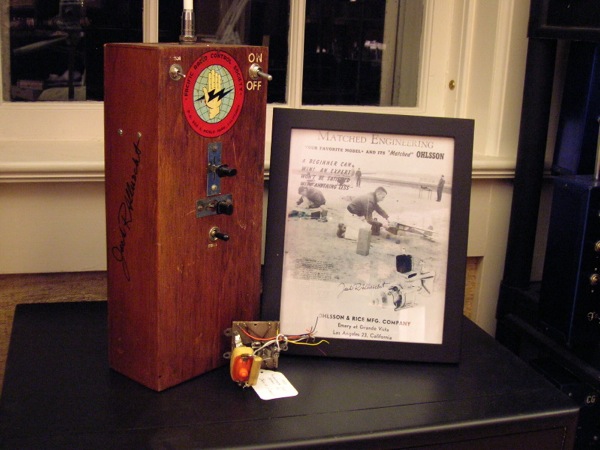
(Click on any of the images on this page to see a larger version)
This is Jack Albrecht’s hand-held wooden case transmitter which he built at Alex Schneider’s house in January, 1956. This and Alex Schneider’s own transmitter (in storage at another museum) are the only two known to exist and may be the first hand-held multi transmitters.
Here is how the back of the Albrecht transmitter appears today, identical except for the following modifications after the ad:
Two channels were added to provide trim ( the reeds – type toggle switch on the front), and this required addition of the two holes immediately above the five forming an “X” pattern for two additional adjustment pots.
A new piece of wood was added at the bottom as a repair.
A decal was added at the top depicting the “R/C Precision Pattern” for contest flying.
The First Reeds
Reed radio control systems were pioneered in California in 1949 by Ed Rockwood. Albrecht, Schneider and others flew the Rockwood radios at their San Francisco Mustang’s flying club. The sets required very large batteries (in an attempt to stabilize the tones) in ground boxes, plus a bulky transmitter and “X” shaped antenna both mounted seven feet above the ground and operated by a hand-held control box on a 6-8 foot cord. As advanced as the system was, it had many limitations, including its size, weight, awkwardness, drifting tone control, maneuverability, restrictions of the 6-8 foot control box cord and its requiring a HAM radio license. Here is a photo of Alex Schneider and his Rockwood reed controlled Schneider cub, to give you a sense for how advanced his hand held transmitter was.
Here is the original 8x10 photo used in the above article:
Around 1955, Alex Schneider decided there had to be a better way. With Rockwood’s help he designed a transmitter which could be held entirely in ones hands, employed the new 27 MHz license-free citizens band and featured a stable audio tone oscillator. This critical stability was achieved with a Hartley audio oscillator circuit, a predecessor to the torroid coils later used for tone stability in reeds.
Up, down, left and right were controlled with two Lever Switches by Centralab (# 1455), the same as on Rockwoods. Engine control was via the spring loaded switch seen in the upper left hand corner. This provided either high or idle engine speed sequentially each time the switch was pushed by means of an onboard escapement. High speed was for take off and general flight with idle enabling descent to landings with the engine still running.
Alex Schneider won many contests including the 1952, 1954 and 1955 R/C event at the AMA Nationals. He did not go to the 1953 Nats. His ground based Rockwood transmitter was used for the earlier events. Alex used his new handheld transmitter in the wooden case to win the 1955 Nationals.
Handheld transmitters eventually became the norm as typified by this common Kraft Sport Series used by Alex Schneider decades later, when radio control had matured.
Living Legend
Jack Albrecht has had an illustrious modeling career for 70 years, most recently being deemed a “living legend” in this August 2007 Model Aviation article. For a complete list of his awards and accomplishments see the hall of fame and biography sections of modelaircraft.org.
One achievement must be mentioned here. Jack worked with Bob Aberle and George Steiner on the AMA’s Frequency Committee to essentially save our beloved hobby by securing crucial bandwidth. In 1976, fliers had only 6 frequencies on the 72 MHz band and one on 75 MHz. Some of these were dangerously shared with RC car and boat modelers and some cities were placing pager transmitters on RC frequencies rendering them unusable.
After years of effort, the AMA Frequency Committee succeeded in obtaining an incredible 50 new RC frequencies for aircraft and 30 for surface use, securing the future of the hobby and fostering its growth.
Here is a photo of Aberle, Albrecht and Steiner receiving AMA awards for this historic accomplishment.
You might call this trio the “Three Amigos of RC”. Amigo, of course, means friend in Spanish and the RC Community couldn’t ask for better friends than these three gentlemen.




